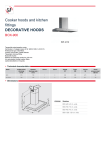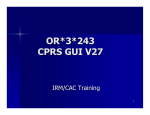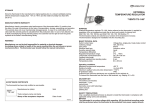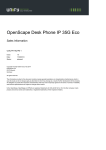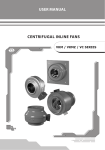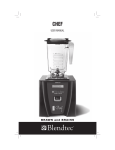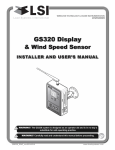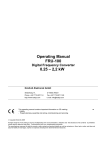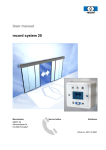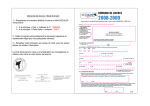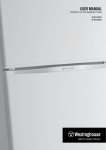Download User`s manual "VENTS KAM" ( PDF 2,39Mb )
Transcript
ÊÀÌ User's manual 2014 2 CONTENT ÊÀÌ 1. Function ð. 3 2. Delivery set ð. 3 3. Basic technical characteristics ð. 3 4. Safety requirements ð. 17 5. Fan structure ð. 17 6. Mounting and setting-up procedure ð. 18 7. Fan connection to power supply network ð. 19 8. Mounting modifications ð. 20 9. Fan wiring diagrams ð. 22 10. Servicing and maintenance ð. 25 11. Storage rules ð. 25 12. Manufacturer's warranty ð. 25 13. Failures and troubleshooting methods ð. 26 14. Acceptance certificate ð. 27 15. Warranty card ð. 27 ÊÀÌ 3 Electric centrifugal fan VENTS KAM in metal casing with impeller diameter range from 146 up to 158 mm with forward curved blades, hereafter referred to as fan, is a part of fireplace heating system and designed for transferring of fresh air with the temperature +150°Ñ from the fireplace hood into various premises through the ductwork to improve chimney efficiency jointly with ventilation system. FUNCTION The fan is suitable for vertical and horizontal mounting and used both for supply ventilation to move warm air from the heating source and for exhaust ventilation to remove warm air excess during ventilation in premises. The fan is easy to use and designed for continuous operation with permanent power supply for the operating temperature ranging from +20°Ñ to +150°Ñ. The fan is equipped with a temperature regulator to set the required temperature value adjustable between 0°Ñ and +90°Ñ. Protection rating from access to dangerous parts and water penetration is IPX2. The delivery set includes: fan - 1 pc; options (in compliance with the purchase order); user's manual; packing box The fan designations, options, operating logic and connecting dimensions are shown in tables 1, 2 and fig. 1-24. The fan design is regularly being improved and some models can slightly differ from those ones described in this manual. DELIVERY SET BASIC TECHNICAL CHARACTERISTICS 4 ÊÀÌ x x x x Temperature regulator: T1 - no built-in temperature regulator Fan modifications: Eco - low power demand EcoDuo - low power demand and switch Eco Bypass - built-in mixing chamber with backdraft damper Eco max - high-powered motor Intake and exhaust branch pipe diameters: 125; 140;150; 160; 200 Fan designation: KAM - centrifugal fan in metal casing Designation key: VENTS KAM 125 - centrifugal fan in metal casing for connection to ø 125 mm round air ducts. VENTS KAM 150 Eco max - centrifugal fan in metal casing for connection to ø 150 mm round air duct equipped with high-powered motor. VENTS KAM 140 EcoDuo - centrifugal fan with low power demand, built-in motor speed switch in metal casing for connection to ø 140 mm round air duct. VENTS KAM 150 Eco T1 - centrifugal fan with low power demand in metal casing for connection to ø 150 mm round air ducts without built-in temperature regulator. VENTS KAM 160 Eco Bypass - centrifugal fan with low power demand in metal casing with built-in mixing chamber and backdraft damper for connection to ø 160 mm round air ducts. ÊÀÌ 5 Options for KAM, KAM Eco max, KAM Eco, KAM EcoDuo: FFK - removable G3 metal filter for transported air purification. The filter is connected to the fan casing by lock-latches for easy removal of the filter for cleaning (fig.3). KFK - removable metal mixing chamber with built-in thermal control damper and G3 filter for transported air purification. The mixing chamber is fixed to the fan casing by means of lock-latches to ensure easy removal for cleaning (fig. 4). The fan configuration with KFK mixing chamber provides cold air supply to the mixing chamber as the operating temperature exceeds 90°Ñ and hot air removal as the motor is off. GFK – gravity backdraft damper to prevent air back draft in the system. The ventilation unit equipped with KFK mixing set and GFK backdraft damper ensures the motor overtemperature protection based on BYPASS actuation when the motor is switched off due to no power supply. The BYPASS system in chimney fans provides gravity backdraft damper shutoff and hot air distribution to other premises through ventilation ducts when the motor is off (fig. 5). Fan accessories: MFK removable filter GFK gravity damper; Metal grilles; Air ducts; Connecting and mounting components; Temperature regulator. The recommended temperature regulators are the remote models for KAM T1, KAM EcoDuo T1 of VENTS production. ÊÀÌ 6 D H 6 7 D B 1-fan casing; 2-inlet flange; 3-terminal box; 4-exhaust flange; 5-temperature regulator; 6-impeller; 7-speed switch (for EcoDuo model). h KAM, KAM Eco max, KAM Eco, KAM EcoDuo fan 1 C A 2 7 h KAM Eco Bypass fan 8 4 5 D D D B 9 C A 7 6 h 2 H 6 1-fan casing; 2-inlet flange; 3-terminal box; 4-exhaust flange; 5-temperature regulator; 6-impeller; 7-mixing chamber; 8-backdraft damper; 9-reverse air duct flange 3 9 2 4 D 5 D B 1-KAM fan; 2-exhaust flange; 3-terminal box; 4-temperature regulator; 5-speed switch (for EcoDuo model); 6-filter casing; 7-inlet flange; 8-filter element; 9-latches. H 8 KAM fan with FFK filter C A ÊÀÌ 7 7 h 6 10 H 8 D KAM fan with KFK damper 11 1-KAM fan; 9 2-exhaust flange; 3-terminal box; 4-temperature regulator; 5-speed switch (for EcoDuo model) 6-mixing chamber; 7-intake flange; 8-thermal control damper; 9-reverse air duct flange; 10-filter element; 11-latches. 2 4 5 D CA D 4 D h H 11 13 2 4 5 CA D 1-KAM fan; 9 2-exhaust flange; 12 3-terminal box; 4-temperature regulator; 5-speed switch (for EcoDuo model). 6-mixing chamber; 7-intake flange; 8-thermal control damper; 9-reverse air duct flange; 10-filter element; 11-latches. 12-gravity backdraft damper; 13-fixing screw. 5 10 8 D KAM fan with KFK and GFK dampers 7 6 D D ÊÀÌ 8 Dimensions [mm] C D Fan type À B ÊÀÌ 125 260 245 210 ÊÀÌ 140 300 285 250 ÊÀÌ 150 300 285 ÊÀÌ 160 300 ÊÀÌ 125 Eco Bypass Í h Weight [kg] 125 350 50 4,5 140 350 50 5,7 250 150 350 50 5,7 285 250 160 350 50 5,7 310 245 210 125 462 50 7,8 ÊÀÌ 140 Eco Bypass 350 285 250 140 522 50 9,8 ÊÀÌ 150 Eco Bypass 350 285 250 150 522 50 9,8 ÊÀÌ 160 Eco Bypass 350 285 250 160 522 50 9,8 7,3 ÊÀÌ 150 Eco max 300 285 250 150 320 50 ÊÀÌ 125 Eco / EcoDuo 260 245 210 125 320 50 5,6 ÊÀÌ 140 Eco / EcoDuo 300 285 250 140 320 50 6,8 ÊÀÌ 150 Eco / EcoDuo 300 285 250 150 320 50 6,8 ÊÀÌ 160 Eco / EcoDuo 300 285 250 160 320 50 6,8 ÊÀÌ 200 Eco 335 350 285 200 350 50 7,8 Table 1 Dimensions [mm] C D Fan accessory type À B FFK 125 260 245 210 FFK 140 300 285 250 FFK 150 300 285 250 FFK 160 300 285 250 Weight [kg] Í h 125 180 50 2,2 140 190 50 3,0 150 190 50 3,0 190 50 3,0 3,8 160 KFK 125 260 245 210 125 260 50 KFK 140 300 285 250 140 300 50 4,0 KFK 150 300 285 250 150 300 50 4,0 KFK 160 300 285 250 160 300 50 4,0 Table 2 ÊÀÌ 9 Designation key t 90 45 Operating temperature range î 45 ~ ~ ~ Temperature regulator with set temperature threshold value. Motor operates Motor is off t Thermal control damper is open t Thermal control damper is closed ~ ~ ~ ~ ~ ~ ~ ~ ~ ~ ~ ~ Gravity backdraft damper is open Gravity backdraft damper is closed Backdraft damper is open Backdraft damper is closed ÊÀÌ 10 KAM, KAM Eco max, KAM Eco, KAM EcoDuo fans operation î ~ ~ ~ î 45 45 t 90 45 t t 45 90 0 45 6 7 KAM Fan with FFK filter operation t 90 î 45 t 45 t 45 0 8 ~ ~ ~ î 45 90 45 9 ÊÀÌ 11 KAM Eco Bypass fan operation t î 45 90 12 î 45 45 t t ~ ~ ~ 90 45 90 45 t t 90 90 45 45 10 11 t î 45 t ~ ~ ~ 25 0 î 45 t 150 90 120 70 t 150 t 90 12 150 90 13 ÊÀÌ 12 KAM fan operation with KFK damper t t î 45 t 90 45 t ~ ~ ~ î 45 t 45 14 15 t t 120 70 25 0 t î 45 t ~ ~ ~ t 150 90 t î 45 t 150 90 16 90 45 0 150 90 17 ÊÀÌ 13 KAM fan operation with KFK and GFK dampers (BY-PASS system). ~ ~ ~ t î t 45 ~ ~ ~ 90 45 t t ~ ~ ~ î 45 t 45 0 18 t 19 t 120 25 ~ ~ ~ t ~ ~ ~ ~ ~ ~ î 45 t 0 70 t î 45 150 90 t t 150 90 20 90 45 150 90 21 ÊÀÌ 14 Installation and operation example of fan models KAM, KAM with FFK filter in the fireplace system. Cold air Flame products Warm air KAM fan Warm air exhaust to the ventilation system FFK filter Warm air withdrawal from the fireplace hood Flame products removal from the chimney to the fume duct Decompression grille Air heating chamber in the fireplace hood Chimney furnace Cold air supply 22 ÊÀÌ 15 Installation and operation example of fan models KAM with KFK damper and KAM with KFK and GFK dampers (BYPASS system) in the fireplace system. Cold air Flame products Warm air Reverse air duct: 1. Hot air removal with the thermal control damper (fig. 13,17); 2. Cold air supply to the mixing chamber for mixing with hot air (fig. 12, 16) KAM fan Warm air exhaust to the ventilation system KFK thermal control damper Warm air removal from the fireplace hood Flame products removal from the chimney to the fume duct Decompression grille Air heating chamber in the fireplace hood Chimney furnace Cold air supply 23 16 ÊÀÌ Installation and operation example of KAM fans in the ventilation system of the premise. Cold air Warm air KAM fan Mounting elements Air ducts Diffusers 24 ÊÀÌ 17 Take actions to prevent ingress of smoke, carbon monoxide and other combustion products into the room through open chimney flues or other fire-protection devices. Fan shall be mounted and installed by a duly qualified electrician im compliance with acting norms and standards. Fan servicing and maintenance are allowed after the fan is disconnected from power supply network. Make sure that the fan is free of any visible damages or any foreign objects inside the casing that may damage the impeller before connecting the fan to power supply network. Power supply cable must not be in contact with any hot fan and air duct surfaces. Fan models KAM, KAM Eco max, KAM Eco (fig. 1,2) consist of the metal casing 1, intake flange 2 and exhaust flange 4 with the diameters equals to the air duct diameters, temperature regulator 5 with the operating range from 0°C to 90°C and terminal box 3 for connecting the fan to single-phase power supply network. Fan modification without terminal box is possible. The fan casing consists of two insulated chambers. The electric motor is installed in a separate chamber protected against overheating from the transported air. The impeller 6 is installed on the motor shaft. KAM EcoDUO fan model is equipped with speed switch 7. KAM Eco Bypass fan model incorporates the mixing chamber 7, the backdraft damper 8 and the reverse duct flange 9 (fig.2). FFK filter consists of the filter casing 6, intake flange 7, removable filtering element 8 and latches 9 (fig.3). FFK filter is connected to KAM fan with latches. KFK damper consists of the mixing chamber 6, intake flange 7, thermal control damper 8, reverse duct flange 9, removable filter element 10, latches 11 (fig. 4). KFK damper filter is connected to KAM fan by means of latches. Joint installation of KFK thermal control damper and GFK gravity backdraft damper 12 provide BYPASS operation for extra motor overheating protection of KAM fans. GFK damper is mounted on the intake flange and fixed by retaining screw 13 (fig.5). SAFETY REQUIREMENT FAN STRUCTURE 18 ! WARNING MOUNTING AND SETTING-UP PROCEDURE ! WARNING ÊÀÌ Use only heat-resistant metal air ducts and grilles while mounting the fan in the ventilation system. Do not use the fan in the explosive or fire hazardous environment. After unpacking the fan make sure of no damages in the power supply line and no cuts and crack in the cable insulation, check the fan casing for no hollows and other distortions. The impeller shall have smooth rotation and be not in contact with the intake flange and the casing. Observe general and special safety precautions during the fan setting-up and operation. The fan shall have reliable grounding. The circuit breaker shall be installed in such a way as to provide easy access and control of the fan start-up procedure. The fan shall be installed vertically or horizontally on a level surface depending on the fan model. The fan mounting options are shown in fig. 25-32. While mounting provide free air access to the fan for its cooling. Install the fan on the mineral wool layer on the rigid fire-resisting plate (gypsum board 0.5 x 0.5 m) to reduce vibration. Keep the minimum distance from the fan to the heating source 1.5 m and the minimum distance from the fan casing to the neighbouring objects 0.5 m. Install the required amount of the decompression grilles in the fireplace hood, intake and air distribution ducts and fix them with the clamps. The air ducts shall have thermal insulation with mineral wool. The intake air duct shall be placed 10-20 cm below the decompression grilles level. Air flow direction in the system shall match the direction of the arrowhead on the fan casing. For KAM B fan models adjust the gravity backdraft damper position in compliance with the arrowhead direction preserving the horizontal damper position. The damper protects the system and the fan from overheating as the chimney is operating and as the fan is off. Set the required temperature threshold value for the fan switching on by means of rotating the control knob. The temperature adjustment range is from 0°Ñ up to +90°Ñ. To prevent ingress of smoke, carbon monoxide and other combustion products into the room check the tightness of the chimney duct and the flame products removal system. ÊÀÌ 19 Do not install the fan on the flammable material or directly in the fireplace hood, do not cover the fan casing and do not mount the fan in the walls or install the fan without decompression grilles. Fan operation beyond the specified temperature conditions ranging from 0°Ñ to +150°Ñ or in premises with aggressive impurities in the air and in explosive environment is prohibited. Switch the fan from power supply network before starting any works with the fan. The fan shall be connected to power network by a qualified electrician. Rated values of the electrical parameters are shown at the manufacturing label. Any modifications of the internal connections are not allowed and result in loss of warranty. The fan shall be connected to AC single-phase 220-240 V/ 50 Hz power supply. The fan shall be connected to power supply by means of insulated, durable and thermalresistant cords (cables, wires) with respective cross section, in any case no less than 0,5 mm2. The stated wire sections in the table are for reference only! The actual selection should be made in consideration of the maximum wire heating temperature depending on the wire and insulation type, the maximum current, the lead wire length and its installation (suspended, channel- or wall-mounted). The fan shall be grounded. The fan connection shall be performed on the terminal block (fig. 29-32) inside the terminal box of the fan in compliance with the wiring diagram and terminal designations (fig. 33-35). The automatic circuit breaker incorporated into the fixed power network that breaks all the phases shall be installed at the external electric input (220-240V, 50Hz). The fan shall be connected to the electrical power supply network with the circuit breaker and the contact gap between open contacts no less than 3 mm on all the terminals. The installation of S1 external switch shall provide unhampered access for a quick shutdown of the fan. The current protection value shall be selected depending on the fan current consumption. The recommended rated current of the automatic circuit breaker is 1.6 À. KAM, KAM Eco, KAM EcoDuo fan models are equipped with built-in thermostat relay that closes the power circuit of the fan as the temperature in the chimney reaches the set value. The fan switches on and supplies warm air to the premise. As the temperature drops below the set value the fan switches automatically off. Installation, connection, adjustment and repair works shall be performed only after the fan is disconnected from power supply network. PROHIBITED ! WARNING FAN CONNECTION TO POWER SUPPLY NETWORK ! WARNING ÊÀÌ 20 MOUNTING MODIFICATIONS KAM, KAM Eco max, KAM Eco, KAM EcoDuo fan KAM fan with FFK filter 25 26 KAM Eco Bypass fan, KAM fan with KFK damper KAM fam with KFK and GFK dampers 27 28 ÊÀÌ 21 S1 29 30 31 32 ÊÀÌ 22 FAN WIRING DIAGRAMS Wiring diagram of KAM, KAM Eco max, KAM EcoDuo fan models with single-phase motor for connection to AC power network. L S1 Wiring diagram of KAM T1 fan model with single-phase motor to AC power network ÂÊ1 X1 L ~230V 50Hz L 1 N PE 3 N 4 PE where S1 - automatic circuit breaker (not included into the delivery list); X1 - terminal block. 33 C X1 T 1 2 ~230V 50Hz 2 N S1 L 1 ÐÅ 2 N 3 4 where S1 - automatic circuit breaker; X1 - terminal block; BK1 - temperature regulator (S1, BK1 are not included into delivery list). 34 Wiring diagram of KAM EcoDuo T1 fan model with single-phase motor to AC power network ÂÊ1 L ~230V 50Hz N PE 35 S1 C T 1 2 S2 max X1 1 H 1 3 L 2 ÐÅ 3 N 4 2 min 5 6 where S1 - automatic circuit breaker; S2 - three-position switch; X1 - terminal block. BK1 - temperature regulator (S1, S2, BK1 are not included into delivery list). ÊÀÌ 23 KAM, KAM Eco max, KAM Eco, KAM EcoDuo fans S1 37 36 KAM Eco Bypass fan 38 KAM fan with FFK filter 39 24 KAM fan with KFK damper 40 KAM fam with KFK and GFK dampers 41 ÊÀÌ ÊÀÌ 25 All servicing and repair works of the fan shall be performed after the fan is fully disconnected from power supply network and all the rotating parts are stopped. Maintenance means periodic clearing of the surfaces from dust and dirt. Use a soft dry brush or compressed air to remove dust. The impeller blades require thorough cleaning every six months. To clean the blades disconnect the air ducts from the fan. Then ñlean the blades with water and detergent solution and avoid water dropping on the electric motor and temperature regulator. In case of any problems related to the fan switching or operation use a troubleshooting table to eliminate the faults (table 3). SERVICING AND MAINTENANCE Fan servicing near an operating chimney is strictly prohibited as the fan components can get warmed up to high temperatures in case of chimney operation while maintenance. Maintenance and repair works are allowed after the time period required for the fan cooling down to the ambient temperature +20°Ñ. Store the fan in manufacturer’s packaging in a ventilated room at the temperature ranging between +5°Ñ and +40°Ñ and relative humidity not more than 80% at +20°Ñ. PROHIBITED STORAGE RULES No acid or alkaline vapours and other aggressive mixtures in the air are allowed. Manufacturer hereby guarantees rated performance of the fan within 24 months since the date of its sale in accordance to the rules of transportation, storage, assembling and operation. In case of no confirmation of the sales date the warranty period is calculated starting from the production date. In case of failure due to faulty manufacturing during warranty period, the Consumer has the right to have it exchanged by the Seller. MANUFACTURER’S WARRANTY The MANUFACTURER shall not be liable for any damages resulting from any misuse of or gross mechanic interference with the fan. The fan owner shall follow the instructions of the manual. ! WARNING 26 FAILURES AND TROUBLESHOOTING METHOD Problem Possible reasons Wrong electrical connection. No power supply to the terminal block. ÊÀÌ Recommended remedy Using a multimeter instrument check power supply on the terminal block. Disconnect the fan from power supply. Check the electrical connection reliability in the terminal block, circuit breaker and socket. Connect the fan following the wiring diagram. The motor speed is too low, the motor or the impeller blades are jammed. Turn the automatic circuit breaker off. Rotate the impeller manually and make sure of no foreign objects inside the impeller that disturb the impeller free rotation. Loosen the impeller fixing screw and adjust the impeller position on the shaft to exclude jamming, tighten the fixing screw. Operating temperature of the air supplied from the chimney to the fan is not sufficient to switch the thermal regulator. Wrong selection of the ducting network from the chimney to the fan. The set temperature at the thermal regulator is too high and it does not generate a signal for the fan switching on. Decrease the set temperature threshold level or increase the air temperature supplied from the chimney. Install the fan closer to the chimney. The automatic Increased current consumption due to short circuit breaker starts circuit in the electric circuit results in as the fan is switched on. switching the automatic circuit breaker on. Switch the fan off. Troubleshoot the increased current consumption source. Check the automatic circuit breaker condition and automatic switch overload current value. Switch the automatic circuit breaker off and on. Switch the fan on again. The fan is not turn on Low air capacity Abnormal noise and vibration Clogged filter in KAM F, KAM K, KAM B fan model. Clogged ventilation system components (diffusers, grilles, air ducts). Clogged impeller blades or soiled flange. Damaged air ducts, closed vents and diffusers. Clean or replace filters in KAM F, KAM K, KAM B fan models. Clean the ventilation system components - diffusers, grilles, air ducts as well as the fan components - the impeller and the flange. Make sure that the air ducts are not damaged and that the diffusers and the vents dampers are opened. The fan is soiled. The screw connections are loose. Clean the fan. Check and tighten the screw connections. Faulty fan installation causes abnormal noise generation due to no anti-vibration elements or fan installation on metal surfaces. Install the fan onto the anti-vibration rubber mounts which are available on a separate order. To do so fix the mounting brackets to the casing and connect the anti-vibration rubber mounts to the mounting brackets. Select another location of the fan and avoid its installation on the metal surface. Faulty fixation of the supply air ducts, the supply air ducts are made of rigid metal. Replace the rigid air ducts with the flexible air ducts with thermal insulation. Tighten the fixing clamp screws with the force to prevent air duct rotation. Table 3 ÊÀÌ 27 The fan VENTS KAM _______________ ACCEPTANCE CERTIFICATE is accepted as serviceable. Stamp of the acceptance inspector Date of manufacture Sold by (Name of the vendor, stamp of the shop) Date of sale WARRANTY CARD V15EN-06 ÊÀÌ




























